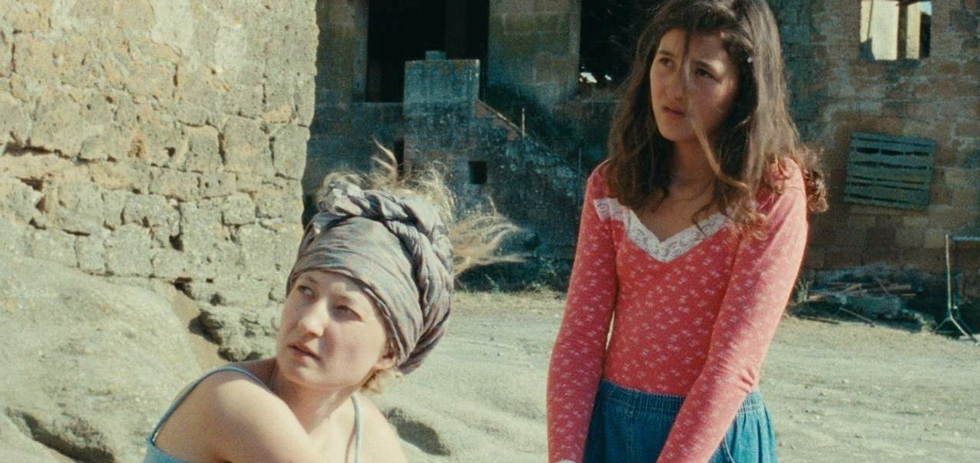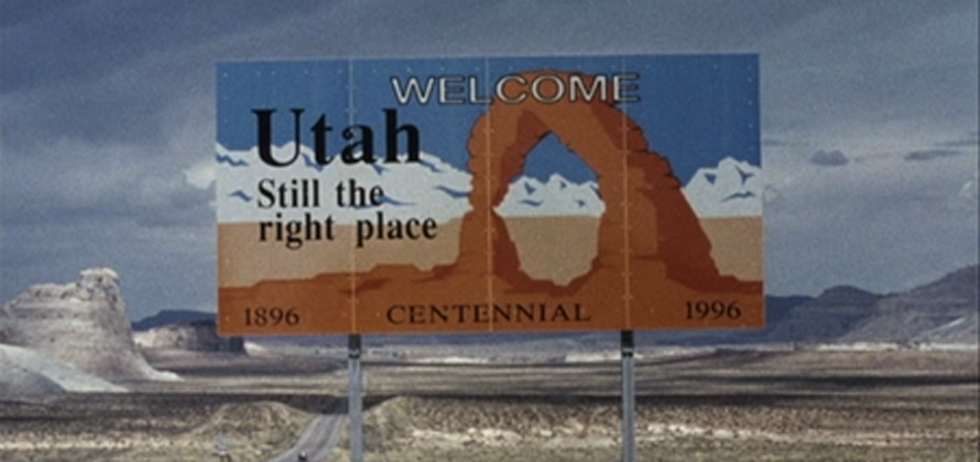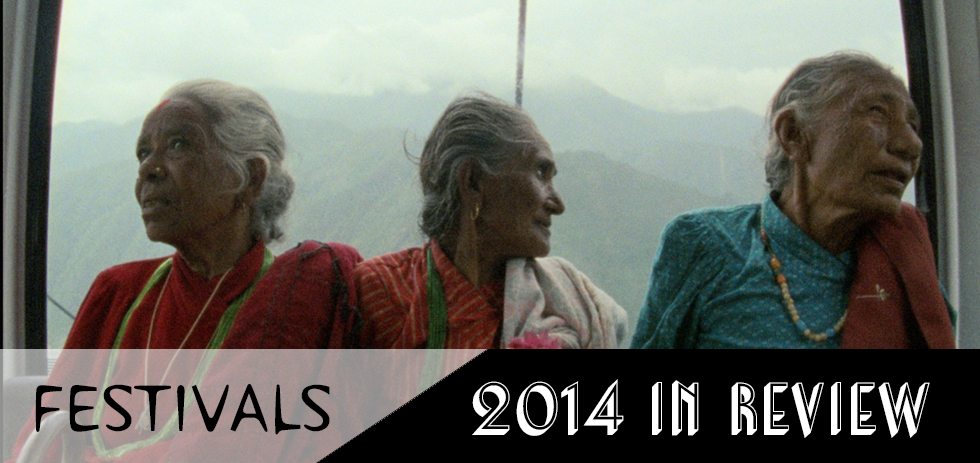In this roundtable discussion looking at the best festival films and film festivals more broadly, we have editors Conor Bateman, Jeremy Elphick and Brad Mariano, sub-editor Jessica Ellicott and contributor Ivan Cerecina.
Brad: In a film climate where mainstream theatrical releases are covering fewer films with the rise of VOD, and with those films lucky enough to find distribution often subject to the dreaded three week window,1 one avenue that has become even more significant in film culture is that of the film festival, and in many respects this side of the industry is booming. With a proliferation of smaller, often culturally specific festivals orbiting around the larger scale institutions that are the storied festivals such as Sydney Film Festival and Melbourne International Film Festival, it feels like the concept of the film festival is more important to the Australian cinephile than ever, certainly a refreshing counterbalance at least in Sydney to the lack of dedicated arthouse and revival cinemas. I might start with a pointed question – was it just me, or was the difference in quality between festival and mainstream films particularly pronounced this year? Off the top of my head, four of the five best things I saw this year didn’t play in a cinema in NSW.
Jess: Well, I’m inclined to agree, but I’d qualify that by saying that there were several daring theatrical releases this year – we were pretty lucky to see the like of Maps to the Stars, The Immigrant and Night Moves get a run in cinemas, albeit in select ones. Maps to the Stars is a good example as it didn’t play at SFF/MIFF and hasn’t even had a US release yet, so it was a bit of a miraculous anomaly that it appeared in Australian cinemas. Why distributors don’t think putting Godard’s Goodbye to Language 3D in every IMAX cinema in the country isn’t a viable financial decision is beyond me. But yes, most of my favourite films this year I saw at festivals, ones that didn’t get a theatrical release (Tsai Ming-Liang’s incredible Stray Dogs, for example). But maybe that speaks more to my personal viewing habits? I see more films at festivals than I do in cinemas, mainly because they show a lot of the films I’m interested in but also purely because it’s cheaper.
Conor: I wasn’t really overwhelmed by the quality of festivals or theatricals this year, though admittedly I didn’t get the chance to go to MIFF, it seemed like there was a lot of good stuff on show there. I actually think that, as lucky as we were to get films like Night Moves, there were a whole host I would’ve loved to see go straight into cinemas. I know Appropriate Behavior and Kumiko, the Treasure Hunter are pencilled in for 2015 theatrical releases but Tom at the Farm having no release outside of ACMI is crazy. I guess part of it is that a lot of festival films seemingly appear to be made for a niche audience. One of the best documentaries I’ve seen all year is Lance Bangs’ Breadcrumb Trail, but I guess it’s hard to pack out Dendy Newtown with Slint fans every other night. Also, while we’re on festival disappearing acts, whatever happened to a theatrical release for Kasimir Burgess’ Fell? It did VOD but only as an experiment and has now been nominated for AACTA awards, seemingly cutting out the audience themselves.
Jess: The AACTAs are a bit funny – Russell Crowe’s The Water Diviner scored eight nominations, and no one’s even seen it yet. Must be a masterpiece…

Ivan: I thought it was a decent enough year for Australian theatrical releases, but the year’s festival releases were far more impressive to me. I liked a fair few films that played in cinemas – Maps to the Stars, Two Days, One Night and The Immigrant probably chief amongst them – but none of them would count amongst my end of year favourites. The two big festivals I went to, MIFF and Filmfest Munich, had very strong selections. MIFF has to be praised not just for the depth of their program, which was inevitable considering the length of the festival, but for its phenomenal retrospective selection. Munich didn’t have the same variety in its program, but it showcased a lot of the big name narrative filmmakers working today. There were some great finds in the CineVision program strand, Alice Rohrwacher’s The Wonders was probably the pick of them for me.
Jeremy: I think MIFF came out as the strongest festival I went to this year. The more nuanced focus on Asian cinema was refreshing and the length and breadth of the festival was a lot calmer than what we experienced at SFF. That said, SFF’s China selection gave me two of the five of my top five films of the year, so that alone is really commendable. I think one of the more interesting things is the performance of the minor festivals this year. While a lot of them weren’t jampacked with the same kind of quality that SFF or MIFF brought, they really provided a much needed place for cinemagoers to get a more nuanced view of a lot of different national cinema landscapes in 2014. KOFFIA was as fast-paced and thrilling as usual, while the Greek Film Festival gave me a lot of disappointments that the international “Greek New Wave” narrative really skims over. Another interesting thing is the quality vs quantity debate in the smaller festivals. The Japanese Film Festival had a colossal line-up this year, but very few of them were compelling or innovative and it gave a really bad portrayal, I feel, of a country that is putting out a heap of fantastic movies at the moment. Most of these better flicks screened, but amidst a lot of trash. What do people think of smaller festival curation – should they be trying to give a holistic portrayal of the cinema landscape in the country or should they be trying to cherry pick the best films?
Brad: That issue does come up in some of the bigger of these culturally specific festivals, it was notable as well at the Lavazza Italian Film Festival – alongside interesting films like Human Capital was something like Stay Away From Me, a horrible rom-com that wouldn’t be a blip on our radar if it was English language. But I suppose that broader vision of the country’s cinema – good films, bad films and many in between – is what some of these festivals are after, especially the larger, Embassy/sponsor funded ones. And like English-language mainstream releases, there likely are large numbers of Japanese/Italian speaking people who do want to see these more crowd-pleasing efforts, and I certainly don’t begrudge them that.
Conor: We’re mostly lucky in Sydney to have this wealth of smaller film festivals that allow us to actually see many of the things that play at Cannes and Berlin but don’t make it into the bigger domestic festivals (mostly as a result of scheduling). There are perhaps too many of them, more an issue for drawing audiences throughout the year, but there have been some really interesting films that have played in these smaller festivals. I didn’t see it but we got Tokyo Tribe at the Japanese Film Festival around the same time it was blowing up in NYC cinemas, the Lavazza Italian Film Festival gave us The Wonders, which I thought was merely ok but still, it’s not only about quality, it’s about access. Because we have limited major festivals, it depends on these smaller ones to provide us access to films making waves on the international circuit. On access, I think because it’s so hard to get a documentary into cinemas unless a celebrity is at the helm or providing the narration, festivals (and VOD) become our major source for documentaries. SFF always puts a big effort into their documentary program and having Antenna Documentary Film Festival in Sydney also helps in getting these films seen.

Jeremy: MIFF really killed it on this. They brought out ‘Til Madness Do Us Part, which was one of my favourites of the year (I caught it earlier at SFF), smaller Kickstarter-funded documentaries like the Elliott Smith focused Heaven Adores You, Time Is Illmatic (the substantially glossier Nas doco), and two Wiseman films for starters. There definitely feels like there’s a shortage of documentaries this year. I know I was seeing them more frequently at festivals a few years ago, though I’m not sure if that is a matter of personal preference. That said, I definitely agree with Conor around the actual subjects of the films where ‘Til Madness comes off as the only documentary not by a major director or about a major subject. I’ve always thought that the best documentaries reveal something the viewer was unaware of beforehand – whether that is a series of facts, a story, or something more complex in the form of a way of accessing the world – and this holds true in my reception of ‘Til Madness in comparison to these other films (many of which are still very strong in their own right). It’d be nice to see more alternative and weird documentaries making their way back into the festival line-up.
Actually, Concerning Violence played at SFF and MIFF too. Göran Hugo Olsson (who was behind Black Power Mixtape a few years back) did this documentary alongside Lauryn Hill as narrator, inspired by Frantz Fanon’s writing in The Wretched of the Earth. The finished piece is one of the most powerful things I’ve seen this year, and it definitely breaks from the typical documentary mold without being high budget or shoddy. Definitely worth a watch.
Jess: This has been a really exceptional year for documentary. My favourites were Frederick Wiseman’s National Gallery, Wang Bing’s ‘Til Madness Do Us Part and J.P Sniadecki’s The Iron Ministry, which played the Brisbane Asia Pacific Film Festival. They are all good indications of the strength of documentary filmmaking right now. The properties of digital are well-suited to documentary methods, in the allowance for longer takes, lower costs and enhanced portability, and I think we’re seeing that potential realised more and more. Not to suggest that film no longer has a place in documentary. Stephanie Spray and Pacho Velez’s Manakamana (pictured in the header image), for instance, was not only shot on film but defined by it structurally, comprised of single shots of cable car rides, lasting the duration of the 16mm film reels they are shot on.
Ivan: I agree with Jess and Jeremy, I thought that this was a great year for documentary films, though I’m yet to see ‘Til Madness Do Us Part. The Harvard Sensory Ethnographic Lab continues to do really interesting thing with the form, as we saw with both The Iron Ministry and the underseen but excellent Manakamana, which was one of the highlights of SFF for me. It shows a concern for the history of documentary film (via Rouch and Robert Gardner), the philosophical and ethical implications of their work, and a real interest in how to approach old subjects in a new way. It goes without saying that the two Wiseman films were great, very inspiring stuff.

Brad: Well we’ve talked about festivals and their importance in bringing cutting edge modern cinema, but the other side of that coin – in a city with very little revival or repertory cinema culture, festivals become hugely important in terms of retrospectives. Unfortunately it is hard to see classic films on the big screen, and also, rarely on actual film – MIFF’s “Celluloid Dreams” program strand this year, where they celebrated films shot on film but showed them on DCP seems to not help this distinction, but more likely to confuse things for the average cinema goer. What did you guys make of the retrospectives this year?
Jess: I do think it is sad that each year we are now supposed to be excited about festivals announcing their screenings of whichever high-profile new DCP restoration of a classic film is doing the rounds (e.g. Charulata and Hiroshima, mon amour this year). I think that while this restoration work is important and worthwhile, we should be seeing warning signs flashing at the growing absence of film from “film festivals”.2 The restoration of Charulata was praised for its preservation of “the look” of film, which to me just seems like a nice way to spin what is essentially an inferior imitation. Ever noticed how often 4K is accompanied by the adjective “glorious”? Somewhere there must be a marketing genius behind that, managing to turn advertising copy into near-accepted truth. Film is art, and artworks should be shown in their original medium. It’s like hanging up a photograph of an oil painting in a museum and expecting people to believe it’s the real thing.
Rant aside: I saw some great retrospectives this year. Highlights include: SFF’s James Benning retrospective guest programmed by Gabe Klinger, MIFF’s Jean-Pierre Léaud and Commedia all’italiana sections and the Japanese Classics program programmed by the Japanese Film Festival at the Art Gallery of New South Wales, which was so good I had to attend every single session in the very real fear I’d miss something great.3 Shoutout to the Austrian Film Museum’s 50-film John Ford retrospective at the Viennale for the retrospective I most wished I could attend and which continues to inspire great content like this article on donkeys in Ford’s films.
Ivan: Yeah, Jess’s criticisms are pretty spot on with regards to film festival retrospectives. Programmers are offered – pending availability of course – the opportunity to engage with a certain aspect of film history through these programs, but they are often too slight or not even in their original formats, which compromises the whole affair. MIFF this year was an obvious exception: the Jean-Pierre Léaud program not only provided some incredibly rare cinema experiences (most notably the entirety of Jacques Rivette’s Out 1 on 16mm), but shed light on the work of an actor as it changed over the years and in the hands of some very different directors. Coupled with the aforementioned Commedia all’italiana and Hong Kong film series, this put MIFF leagues ahead of the competition in curating retrospectives that rewarded sustained attention from festival-goers.
Conor: I didn’t get to many retrospectives this year but I can definitely echo Jess when it comes to the SFF’s James Benning retrospective, which was really enjoyable, especially since we got to see some of his films on film, something that surely elevated Deseret and, in fact, is probably a vital component, considering the way that film comments on the proliferation of opinions printed.
Jeremy: MIFF actually had a completely left field Hong Kong retrospective too. I think it fell a bit under the radar because a lot of the screenings for it weren’t that full. A Perfect Midnight: A Haunted Hong Kong was a selection intricately curated around Hong Kong horror from the 60s to the early 90s and gives a fairly strong idea of what people should be expecting from retrospective curation. It’s refreshing, it’s looking at directors who didn’t get due credit in their day, and it’s moving away from a really canon-heavy concept of the retrospective that has haunted film festivals for decades. I’m liking this new appeal to nuance and more out of the way choices for subjects.
Brad: Dino Risi’s Il Sorpasso was likely the best film of any kind that I saw in a theatre all year, so put me down as another voice singing the praises of Melbourne’s retrospective programming. Though like Jess, I’m also hoping the 50-film Ford retrospective makes its eagerly awaited Australian pit-stop next year. But I think we’ve touched on how important film festivals are to cinema culture going forward, and hopefully Australian festivals continue to thrive in 2015 as we await announcements and rumours in the next few months, where the power of festivals is perhaps most ominously apparent – for film buffs, there’s often the feeling that festivals are the last resort for much of the awaited arthouse/foreign cinema; that if the latest film by your favourite director isn’t picked up by the local festival, with it likely goes your only chance to catch it on the big screen. To paraphrase a classic arthouse film, with great power comes great responsibility for these programmers, and we can’t wait to see what 2015 brings.
Top 5 Festival Films
Brad Mariano
- Hard to Be a God (Melbourne International Film Festival)
- Story of My Death (Melbourne International Film Festival)
- Stray Dogs (Melbourne International Film Festival)
- Journey to the West (Melbourne International Film Festival)
- Abuse of Weakness (Sydney Film Festival)
Conor Bateman:
- Fish & Cat (Sydney Film Festival, Iranian Film Festival)
- Tom at the Farm (Sydney Film Festival, Possible Worlds Film Festival)
- Kumiko, the Treasure Hunter (Sydney Film Festival)
- Non-Fiction Diary (Antenna Documentary Film Festival)
- Appropriate Behavior (Sydney Film Festival, Queer Screen Film Festival)
Jeremy Elphick:
- Lake August (Sydney Film Festival)
- Hard to Be a God (Melbourne International Film Festival)
- ‘Til Madness Do Us Part (Sydney Film Festival)
- Timbuktu (Melbourne International Film Festival)
- Story of My Death (Melbourne International Film Festival)
Jessica Ellicott:
- Stray Dogs (Melbourne International Film Festival)
- National Gallery (Sydney Film Festival, Melbourne International Film Festival)
- The Strange Little Cat (Audi Festival of German Films)
- Amour Fou (Melbourne International Film Festival)
- ‘Til Madness Do Us Part (Sydney Film Festival)
Ivan Cerecina:
- Story of My Death (Filmfest Munich, Melbourne International Film Festival)
- At Berkeley (Sydney Film Festival)
- Stray Dogs (Melbourne International Film Festival)
- Goodbye to Language 3D (Melbourne International Film Festival)
- Jauja (Melbourne International Film Festival)
